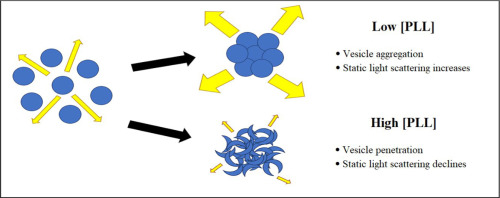当前位置:
X-MOL 学术
›
BBA Biomembr.
›
论文详情
Our official English website, www.x-mol.net, welcomes your
feedback! (Note: you will need to create a separate account there.)
Penetration of phospholipid membranes by poly-l-lysine depends on cholesterol and phospholipid composition.
Biochimica et Biophysica Acta (BBA) - Biomembranes ( IF 2.8 ) Pub Date : 2019-11-15 , DOI: 10.1016/j.bbamem.2019.183128 Amy Gorman 1 , Khondker R Hossain 2 , Flemming Cornelius 3 , Ronald J Clarke 4
Biochimica et Biophysica Acta (BBA) - Biomembranes ( IF 2.8 ) Pub Date : 2019-11-15 , DOI: 10.1016/j.bbamem.2019.183128 Amy Gorman 1 , Khondker R Hossain 2 , Flemming Cornelius 3 , Ronald J Clarke 4
Affiliation

|
Clusters of positively-charged basic amino acid residues, particularly lysine, are known to promote the interaction of many peripheral membrane proteins with the cytoplasmic surface of the plasma membrane via electrostatic interactions. In this work, cholesterol's effects on the interaction between lysine residues and membranes have been studied. Using poly-l-lysine (PLL) and vesicles as models to mimic the interaction between lysine-rich protein domains and the plasma membrane, light scattering measurements indicated cholesterol enhanced the electrostatic interaction through indirectly affecting the negatively charged phospholipid dioleoylphosphatidylserine, DOPS. Addition of PLL to lipid vesicles containing DOPS showed an initial increase in static light scattering (SLS), attributed to binding of PLL to the vesicle surface, followed by a slower continuously declining SLS signal, which, from comparison with fluorescent dye leakage studies could be attributed to vesicle lysis. Although electrostatic interactions between PLL and the membrane were not necessary for penetration to occur, cholesterol promoted membrane disruption of negatively charged vesicles, possibly by increasing the electrostatic interactions between PLL and the membrane. In contrast, cholesterol lowered the susceptibility of uncharged vesicles (formed using dioleoylphosphatidylcholine, DOPC) to PLL penetration. This can be explained by the absence of electrostatic interactions and cholesterol's known ability to increase membrane thickness and mechanical strength. Thus, the ability of cationic peptides to penetrate membranes including cholesterol is likely to depend on the membrane's PS:PC ratio.
中文翻译:

聚-1-赖氨酸对磷脂膜的渗透取决于胆固醇和磷脂的组成。
已知带正电荷的碱性氨基酸残基,特别是赖氨酸的簇通过静电相互作用促进许多外周膜蛋白与质膜的细胞质表面的相互作用。在这项工作中,已经研究了胆固醇对赖氨酸残基和膜之间相互作用的影响。使用聚-1-赖氨酸(PLL)和囊泡作为模型来模拟富含赖氨酸的蛋白结构域和质膜之间的相互作用,光散射测量结果表明胆固醇通过间接影响带负电的磷脂酰二油酰基磷脂酰丝氨酸DOPS增强了静电相互作用。在含有DOPS的脂质囊泡中添加PLL会显示出静态光散射(SLS)的初始增加,这归因于PLL与囊泡表面的结合,其次是较慢的连续下降的SLS信号,与荧光染料泄漏研究相比,这可能归因于囊泡溶解。尽管PLL和膜之间的静电相互作用不是渗透发生所必需的,但胆固醇可能通过增加PLL和膜之间的静电相互作用来促进带负电荷的囊泡的膜破坏。相反,胆固醇降低了不带电荷的囊泡(由二油酰基磷脂酰胆碱,DOPC形成)对PLL渗透的敏感性。这可以通过缺乏静电相互作用和胆固醇已知的增加膜厚度和机械强度的能力来解释。因此,阳离子肽穿透包括胆固醇在内的膜的能力可能取决于膜的PS:
更新日期:2019-11-15
中文翻译:

聚-1-赖氨酸对磷脂膜的渗透取决于胆固醇和磷脂的组成。
已知带正电荷的碱性氨基酸残基,特别是赖氨酸的簇通过静电相互作用促进许多外周膜蛋白与质膜的细胞质表面的相互作用。在这项工作中,已经研究了胆固醇对赖氨酸残基和膜之间相互作用的影响。使用聚-1-赖氨酸(PLL)和囊泡作为模型来模拟富含赖氨酸的蛋白结构域和质膜之间的相互作用,光散射测量结果表明胆固醇通过间接影响带负电的磷脂酰二油酰基磷脂酰丝氨酸DOPS增强了静电相互作用。在含有DOPS的脂质囊泡中添加PLL会显示出静态光散射(SLS)的初始增加,这归因于PLL与囊泡表面的结合,其次是较慢的连续下降的SLS信号,与荧光染料泄漏研究相比,这可能归因于囊泡溶解。尽管PLL和膜之间的静电相互作用不是渗透发生所必需的,但胆固醇可能通过增加PLL和膜之间的静电相互作用来促进带负电荷的囊泡的膜破坏。相反,胆固醇降低了不带电荷的囊泡(由二油酰基磷脂酰胆碱,DOPC形成)对PLL渗透的敏感性。这可以通过缺乏静电相互作用和胆固醇已知的增加膜厚度和机械强度的能力来解释。因此,阳离子肽穿透包括胆固醇在内的膜的能力可能取决于膜的PS:











































 京公网安备 11010802027423号
京公网安备 11010802027423号